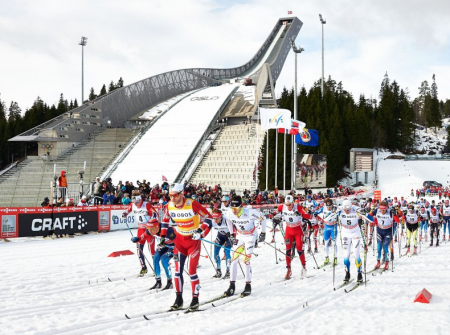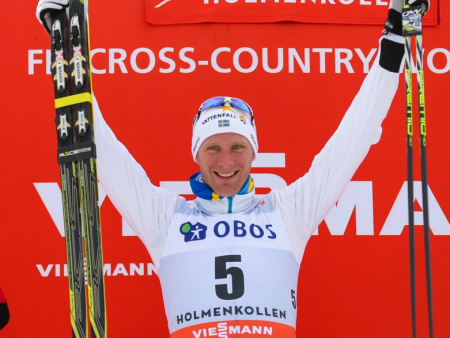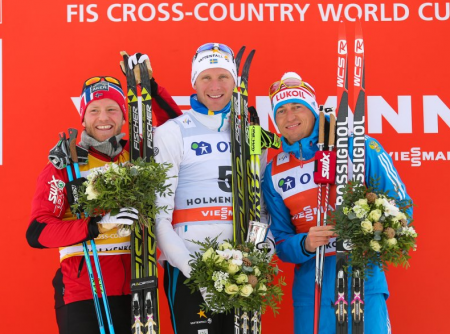
Daniel Richardsson of Sweden carefully paced himself throughout the grueling 50 kilometers to win in Saturday’s classic mass start World Cup at Holmenkollen in Oslo, Norway.
The race started fast, with skiers hungry to win the bonus points located 3 k into the course at the top of the long Frognerseteren climb. Noah Hoffman of the USA called these bonus points, 15 to the winner on each lap, the “easiest points on the World Cup,” and they made for a tempting prize.
Martin Johnsrud Sundby of Norway, the overall World Cup leader, wasted no time in trying to secure his grasp of the title, and charged ahead up the climb just minutes into the race.

Two kilometers into the course Simi Hamilton of the USA could be seen skiing up front with Sundby, climbing up toward the bonus points with Oslofjorden visible far below. Soon the pace increased up the slope and Hamilton fell back, but Hoffman managed to take second at the bonus points, just behind Sundby.
Sundby continued to stay in front and by 10 k he was stretching the race out as it headed into the second bonus points at 11.3 k. As Hoffman described it, “I’ve never seen anything like that, where the best skier in the world decides to go the second time up the climb, not even 10 k into the race at that point. Sundby was pushing the pace at the bottom of the climb; if it was just about the points he did not need to go that early. It looked to me that he was trying to blow the race open, which he did successfully.”
10 k into the race there were four other skiers left with Sundby: Alexander Legkov of Russia, Finland’s Livo Niskanen, Sweden’s Richardsson, and Lukas Bauer of the Czech Republic.
After the second lap all of the leading skiers pulled into the ski exchange except for Bauer, who looked to make a breakaway on the other four men. Bauer gained a twenty-second advantage by opting not to change skis. Sundby and Legkov led the chase, and Bauer’s advantage lasted less than four kilometers. By the 20 k marker he had been caught.
At this point Richardsson also ran into trouble when he somehow fell in the loose snow coming around a corner. “I thought it was useless, clumsy, [I’m] done,” he said of his fall. “It was a bit tricky in the curves.” Richardsson recovered, and soon caught up.
Sundby did the majority of the work at the front of the race, cheered on by the raucous crowd at Holmenkollen. 33 k into the race Sundby took the lead pack into the exchange for the second change of skis. Legkov, Richardsson, and Niskanen followed close behind him. Bauer had been dropped by over 30 seconds.
Shortly after the exchange it was Niskanen who was unable to stay with the pace, and by 36 k he was 18 seconds behind Sundby in the lead.

With three men left in contention for the race, it was Sundby and Legkov who traded leads, with Richardsson skiing behind the two. Sundby at times appeared fatigued in the lead, stumbling at one point up a climb, and at the top of Frognerseteren he comically slouched and hung his arms when Legkov looked at him inquisitively to see if he would continue to lead.
Yet Sundby was strong enough to make an attack up a climb at 47 k, his last bid to win the day. Richardsson managed to stay with the Norwegian, but Legkov lost contact by a couple of seconds. The Russian fought to catch up and nearly did, but soon fell back again.
Sundby led over the last hill, and as soon as the Holmenkollen stadium came into view with 800 meters left, Richardsson took off with a burst of speed that an exhausted Sundby couldn’t match.
Richardsson carried his lead into the finish line to win with a time of 2:07:29. Sundby was second, securing the overall World Cup title, and Legkov was third.
After the race Richardsson told FIS, “The speed was very high from the beginning. The bonus sprints helped to increase the pace. I had a small crash in a downhill and lost some seconds on Martin [Sundby] and Alexander [Legkov]. Then I decided to take it easy and save some energy for the finish. I had a difficult summer but I always believed I could be winning again. It feels great to win in Holmenkollen. I hope a big crowd is coming to Falun next week.”
Richardsson’s difficult summer referred to an accident that occurred outside his family home when a camper van struck Richardsson and a close friend while they were changing a tire, killing his friend instantly and causing Richardsson a femoral fracture and tore the cruciate ligament in his knee.

Talking to Swedish newspaper Expressen after the race, Richardsson said, “It’s been a long road and walk. But I’ve always believed in this. I had a dream, and you have to believe in what you do. I found a form of exercise that works. I have become more careful in what I do.”
A proud Richardsson met with the Norwegian royal family after the race, as the Holmenkollen tradition dictates. However, the Swede was unfamiliar with the appearance of the king and was uncertain if he was speaking with the Norwegian monarch.
“It was a little awkward at first,” said Richardsson. “I did not recognize him at first. He congratulated me. He thought it was a nice race and that it was funny that a Swede had won.”
For Sundby, who finished second last year at Holmenkollen to Legkov, it was a little frustrating to be the runner up. “It sucks to be second again,” Sundby said to NRK, “but I nailed the World Cup. And that’s huge for me. I’ve dreamed about it since I was little.”
“I really tried to win but Daniel [Richardsson] was stronger and smarter than all of us. I did not have a chance in the finish against him,” Sundby told FIS. “It was really fun to race today, we were a small group skiing upfront. The crowds were incredible. I tried to speed up in the second lap. We managed to open a good gap. We had a good dynamics in the front group.”
Indeed, Sundby and Legkov appeared to work well together, and at one point Sundby gave Legkov a fist bump at the top of Frognerseteren.
Sundby’s aggressive pace throughout the race may not have won him the race in the end, but he secured 81 bonus points throughout race, enough that he had secured the overall World Cup title before he even crossed the finish line.
Only five Norwegians have won the prestigious Crystal Globe: Vegard Ulvang, Bjørn Dælhi, Thomas Alsgaard, and Peter Northug. “I’ve looked up to many of these athletes my whole life, so to be on such a list is very large,” said Sundby.

“I’ve slept many a night out in a tent, waiting for my role models who were going out to ski the 50 k,” said Sundby to NRK, recalling the tradition among fans to sleep out on the course the night before the race. “I still remember when I was 10 years old sitting in the woods here, along with Simen Østensen, and that year [Pietro] Piller Cottrer won the race here. It’s really fun to be in the position that I am now the one out on the course.”
“I am little bit disappointed about third place,” said Legkov, “However, I am stronger in free technique so third place in classic feels like a victory. After Sochi in Lahti I have been both mentally and physically tired. I felt in better shape today.”
In a television interview Legkov also said, “I think Daniel [Richardsson] was a little lazy today, but it was a good tactic.”
Holmenkollen was the final race for Tobias Angerer’s long career for Germany. The 36 year-old capped off a 15-year World Cup career Saturday that has included winning the Tour de Ski and the overall World Cup twice.
Results:
1. Daniel Richardson (SWE) 2:07:29.5
2. Martin Johnsrud Sundby (NOR) +8.2
3. Alexander Legkov (RUS) +14.5
4. Livo Niskanen (FIN)+1:22.3
5. Lars Nelson (SWE) +1:55.3
North American Results:
14. Alex Harvey
29. Noah Hoffman
51. Erik Bjornsen
54. Simi Hamilton
56. Reese Hanneman
Pasha Kahn
Pasha Kahn writes and coaches in Duluth, Minnesota.
